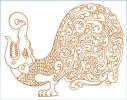Karava of Sri Lanka
Christianity -
Christianity - Catholic, Methodist, Anglican, Protestant

An old Karava flag from the Portuguese period. It incorporates Catholic icons with traditional royal symbols of the Karava .

Another Catholic flag found in a old Karava flag collection.
In Negombo, Chilaw, Jaffna, down south and in the interior there are scores of Cathedrals and churches either built or supported by Karavas.

The entrance to our Lady of Carmel Cathedral in Chilaw, before it was modernised.
Researchers who seem to have done superficial research on Sri Lanka have stated that marginal groups were the first to convert to Catholicism. However Portuguese records from the period show that the Portuguese strategy was to first convert the Royal family and nobles and to use them as examples for others to follow. The conversions in the Kotte and Jaffna kingdoms have followed this method. Some interesting research in this regard has been published by Alan Strathern in Kingship and Conversion in Sixteenth-Century Sri Lanka, Cambridge University Press 2007
In a letter written on 20th March 1557 to the guardian of the religious order, The king of Portugal, King John III himself, expresses his joy as follows on the conversion of a Karava Patangatim and his people : “I am much pleased to rejoice at the news you give me of how our lord has been pleased through the agency of the members of your order to illuminate the Nation of the Carias who you say live in the ports of Ceylon, and are said to exceed 70,000 souls, whose captain named Patangatim accompanied them” (Queyroz 327).
The Jesuit annual letter of 29/12/1606 from Cochin states that the early Portuguese missionaries first concentrated on converting the Karava Patabändas as they were the leaders and rulers of the people. They were used as examples for other gentiles to follow (Perniola II.254) The Portuguese have documented many instances where hundreds of others converted, following the Patabända’s conversion (Perera. C.A. & L. R. 1916 II.24).
Similarly, in Jaffna, in 1623 the Portuguese baptized King Pararajasekaran IX’s two queens as Dona Clara da Silva and Dona Antonia da Silva, several nephews of the king, nine Patabändas and all other chief persons of the Karava caste.(Perniola Portuguese period III)
Some scholars believe that the numerous St. Mary's and St. Anne's churches in the maritime provinces display the transformation from previous worship of Mariamman and Kaliamman.
Karavas have been prominent Bishops and held other high ecclesiastic positions in all denominations. The first People's warden of St. Peter's Church, Koralawella was from the Karava de Mel family. Charles Harold, a grandson of C. H. de Soysa was the second native Bishop of Sri Lanka.

Above: The fist Sri Lankan Bishop, Rt. Rev. Dr. Edmund Peiris OMI, the former Bishop of the Diocese of Chilaw and
below: Rt. Rev. Dr. Frank Marcus Fernando, former Bishop Emeritus of Chilaw from the Karave MIhindukulasuriya clan.


Above: Fr. S. G. Perera
 Above: Arnold Alexander (1857-1888) from the Karawe Weerasooriya family was the first non-European Colonel of the Salvation Army and second in command of the entire Indian sub-continent
Above: Arnold Alexander (1857-1888) from the Karawe Weerasooriya family was the first non-European Colonel of the Salvation Army and second in command of the entire Indian sub-continent

Above: Holy Emmanuel Church Moratuwa built by the Karawe de Soysas.
The British Governor and lady Mc Carthy were present when the church was consecrated by Bishop Chapman on 27th December 1860.
Below: an interior view


Above: Prince of Wales College Moratuwa built by the Karava De Soysa family. It was built as a leading center of Christian education. The adjoining Princess of Wales College too was built by the De Soysas

Above: St Lukes Church, Moratuwa built by the Karave family of Mr. Manuel de Mel

His Eminence Patabendige Don Malcolm Ranjith (1971-1975) was ordained a priest at 27 by Pope Paul VI in Rome, consecrated a Bishop at 43 by Pope John Paul II, elevated an Archbishop at 53 by Pope John Paul II and was made a Cardinal at 62 by Pope Benedict XVI.
He is from a Karava Patebendige family - the royalty of Sri Lanka - see Patabendige.
Kshatriya Maha Sabha, Sri Lanka
